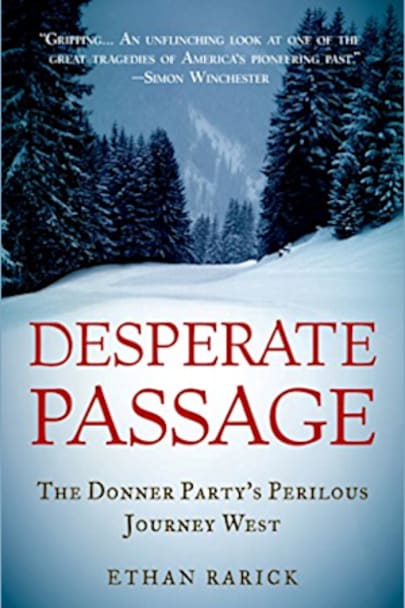In late October 1846, the last wagon train of that year’s westward migration stopped overnight before resuming its arduous climb over the Sierra Nevada Mountains, unaware that a fearsome storm was gathering force. After months of grueling travel, the 81 men, women and children would be trapped for a brutal winter with little food and only primitive shelter. The conclusion is known: by spring of … of the next year, the Donner Party was synonymous with the most harrowing extremes of human survival. But until now, the full story of what happened, what it tells us about human nature and about America’s westward expansion, remained shrouded in myth.
Drawing on fresh archaeological evidence, recent research on topics ranging from survival rates to snowfall totals, and heartbreaking letters and diaries made public by descendants a century-and-a-half after the tragedy, Ethan Rarick offers an intimate portrait of the Donner party and their unimaginable ordeal: a mother who must divide her family, a little girl who shines with courage, a devoted wife who refuses to abandon her husband, a man who risks his life merely to keep his word. But Rarick resists both the gruesomely sensationalist accounts of the Donner party as well as later attempts to turn the survivors into archetypal pioneer heroes. “The Donner Party,” Rarick writes, “is a story of hard decisions that were neither heroic nor villainous. Often, the emigrants displayed a more realistic and typically human mixture of generosity and selfishness, an alloy born of necessity.”
A fast-paced, heart-wrenching, clear-eyed narrative history, A Desperate Hope casts new light on one of America’s most horrific encounters between the dream of a better life and the harsh realities such dreams so often must confront.
more



I was gripped by this book all the way through. It tells the story of a party of pioneers travelling from Illinois to California in 1846, to start a new life. But they made 3 fatal mistakes: they set off too late, they travelled too slowly, and, instead of taking the traditional route up into Oregon and down into California, they took a short cut, the ‘Hastings Cut-Off’, little knowing that Lansford Hastings, who was trying to lure more Americans into Mexico-owned California, had never actually tested the route himself. Somewhere between a third and a half of the pioneers perished en route.
The account is fascinating on so many levels: Rarick gives a great insight into the characters of the travellers, and I actually found it easier to follow the large cast in this non-fiction account than in the novel. I like that he dispelled many of the myths about the relationship between the travellers and the native Americans; for the most part, the latter were helpful, and friendly.
The already difficult journey becomes tragic in the extreme once the party realises that they have hit the mountains at the onset of winter; a large section of the book is concerned with this part of the journey, with all its horrors; starvation, divisions in the group, failed attempts to cross the high peaks, many deaths, and cannibalism. Rarick has given all viewpoints, taken from those who survived it, the rescuers, and the accounts in the newspapers afterwards.
The last part of the book is spent discussing what was true, what was exaggerated, and the downright lies that were conjured up for the purpose of selling books and newspapers. Also, he tells what happened to the survivors after their ordeal was over.
Most tragic of all is the thought that within some of the survivors’ lifetimes, new technology would have made their crossing so much easier, saving many lives.
A terrific book that I recommend most highly.
In October 1846, as part of the last wagon train making the westward migration towards California, the group that became known as the Donner Party were forced to dig in at the foot of the Sierra Nevada Mountains. Unable to make the arduous climb to finish their journey due to the oncoming snows of winter, the group were left trapped without shelter, with little food and woefully ignorant of the fate awaiting them.
Although I was aware of the story of the Donner Party, the facts of their journey were largely new to me. Unlike some writers of historical events, Ethan Rarick has created a very readable and accessible account of an ill-fated trip that left 81 individuals facing a truly horrifying and gruesome future. Having made several mistakes in their choices along the route, the Donners, Reeds and others took the untested Hastings Cut-off in a bid to shorten their journey, but soon found themselves incapable of continuing. With some members of the party already ill, it was inevitable that some would die, though the true horror facing those left alive would haunt the survivors for years afterwards.
Including new archaeological evidence and recent research, the author paints a vivid picture of life on the trail, highlighting the realities of the emigrants’ plight amid a series of disasters and bad decisions.
An enthralling and horribly compelling read.